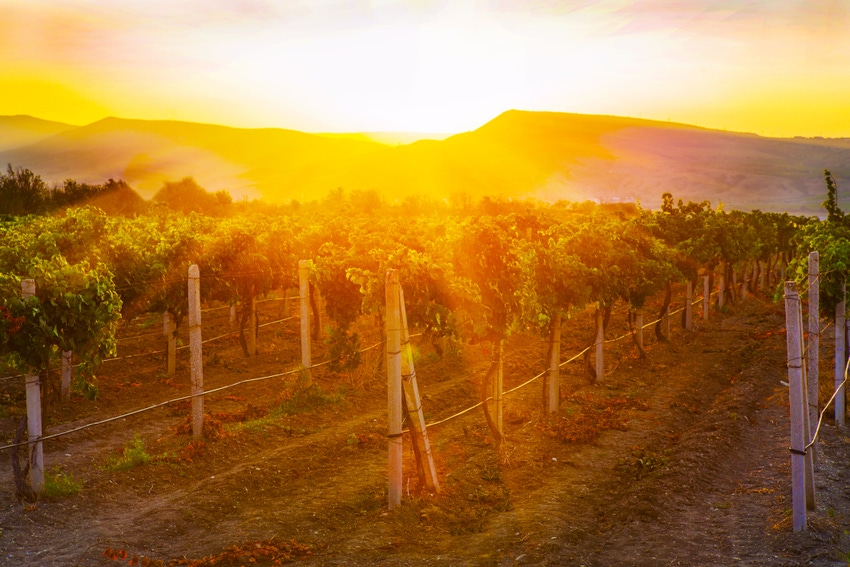
“Our season is starting out wet,” says Central Coast viticulturist Dr. Lowell Zelinski. “But, it’s been so dry for so long, no one’s complaining.”
He’s echoing the thoughts of many California growers following the drought-busting rains that have drenched many areas of the state this past winter.
Owner of Precision Ag Consulting, Paso Robles, Calif., he’s been working with wine grape growers in the Central Coast for more than a decade.
Rainfall in San Luis Obispo County around Paso Robles has totaled about 110 percent to 115 percent of normal since July of last year.
All that water should help improve soil productivity in the area’s vineyards by flushing accumulated salts out of the root zones. Most vineyards here are drip-irrigated, a practice which results in minimal leaching of salts in the soil.
“The high rainfall should produce good movement of salts out of the root zone and, by reducing competition between the nutrient and the salts, it will make it easier for nutrients to be taken up by the vines.”
But that may not be the case for any nitrogen applied last fall, he adds. Growers here commonly treat their vineyards with a shot of nitrogen in the fall to be taken up by the vines before the rains start. That nitrogen is then stored in the trunk for use the following spring in getting the next crop off to a healthy start.
However, this year the wet soils probably caused the fall-applied nitrogen in some vineyards to leach below the root zones before the vines could take it up, Zelinski notes. That’s why he’s advising his clients to test vine tissue for nitrogen levels during bloom.
“Tissue sampling will be especially important this year to see if the nitrogen they put on last fall is actually in the vine and doing its job,” he says. “If not, it makes sense to correct any deficiency.”
By keeping workers out of the fields, the wet soils delayed pruning in many area vineyards. Usually, growers here are done by mid-March. This year, though, some growers still hadn’t finished by mid-April. By then, shoots in many vineyards had grown to about 8 to 12 inches in length
However, in a very few cases, he adds, late pruning may prevent the most productive buds, the first two on the canes, from starting to produce shoots until early May. That, of course, would likely delay growth and ripening of the fruit.
Zelinski doubts the soils remained wet enough after the vines broke dormancy to damage the vines. Those growing in swales, where water tends to collect, may be the exception. “It will be interesting to watch those areas to see how the vines are affected,” he says.
Continuing rains in April have increased the threat of powdery mildew infections in the vineyards this year. “The disease-causing fungi love rain, which makes it easier for them to spread,” Zelinski says. “Also, if the soils are too wet, growers can’t get into the fields to apply fungicides. Once they do, any additional rain will wash away the materials.
“So I’m a little concerned about how bad the powdery mildew pressure will be early in the season. The more fungal spores in the vineyards the faster the infections can spread. While it probably won’t be a complete disaster, growers should be aware of the potential for higher than usual pressure from the disease this year.”
Unlike 2015, when wine grape production declined dramatically, likely due primarily to cool temperatures during the previous year’s bloom, 2016 tonnage was average or higher in most area vineyards, Zelinski says. However, red blotch disease, which slows accumulation of sugar in the fruit, caused the quality of many varieties of the 2016 grape crop to suffer.
“By the middle of October last year, grape Brix levels were still in the 21º-22º range and increasing very slowly even as the threat of fall rains increased,” Zelinski says.
Two trunk diseases, Botryosphaeria dieback or Bot canker and Eutypa dieback, have also caused increased concern among many Paso Robles growers. Zelinski estimates that 15 percent to 20 percent of the vineyard acreage in the Paso Robles area is affected by these fungal diseases.
Typically, the diseases start at the end of the cordon and then gradually work back towards the trunk, killing spurs, arms, cordons, canes, and sometimes the upper section of the trunk, depending on the spread of the wood canker.
To combat the disease, many growers are switching from cordon-trained, spur-pruned vines to those that are head-trained and cane-pruned in an attempt to prevent the disease from reaching the trunk.
Others, who can afford the expense, are simply removing entire blocks of vines infected with these trunk diseases and replanting, Zelinski says.
Meanwhile, demand for this year’s Central Coast grape crop is slipping, he reports. “Over the winter, demand from wineries was strong,” he says. “But, now, as conditions in the vineyards seem to be OK, wineries are holding off on signing any new production contracts until they get a better idea of the prospects for this year’s crop. Right now it’s hard for growers to sell grapes for this fall.”
Still, growers in his area don’t seem to be fretting much, if at all, about this year’s wine grape season.
“In general, they’re pretty optimistic,” Zelinksi says. “They’re thinking that, with the winter rains, the salts are gone and their wells will have enough water. Their mood is kind of upbeat.”
About the Author(s)
You May Also Like




